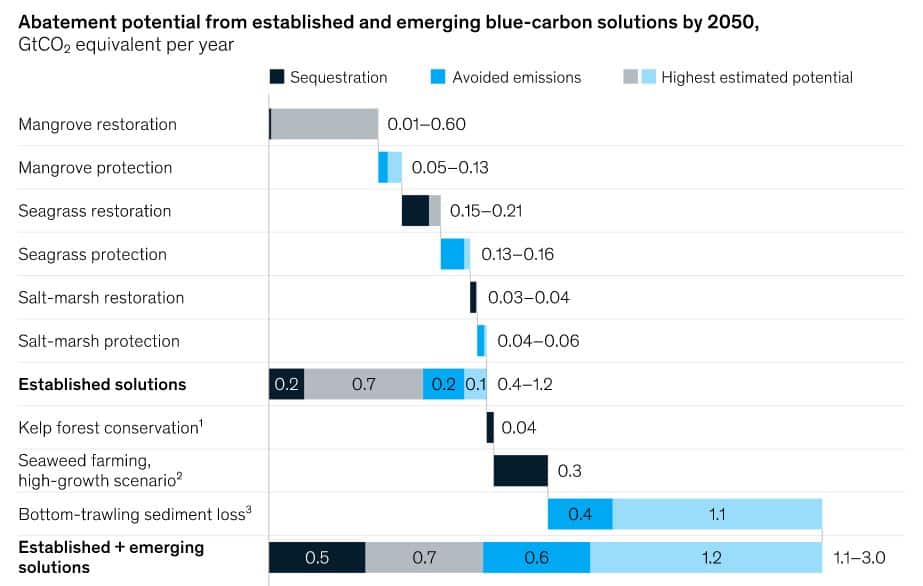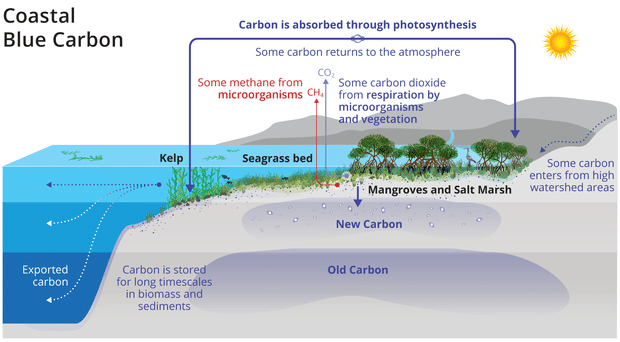A new study led by the University of Michigan shows that Caribbean seagrasses provide several ecosystem services worth $255 billion a year, including $88 billion in carbon storage.
The U of M research team is the first to put a dollar value on the various services that Caribbean seagrasses provide, including fish nurseries, storm protection, and huge carbon storage abilities.
A marine ecologist and the senior author of the study, Jacob Allgeier, highlighted the potential of seagrass carbon capture and storage for the blue carbon market, saying:
“Because seagrass ecosystems are both highly important for carbon storage and sequestration, and are highly degraded globally, they represent an important burgeoning market for blue carbon.”
But seagrasses are also under significant threat of degradation due to global warming, pollution, shipping, and coastal development. Protecting them is crucial as they are our great allies in fighting the climate crisis. Blue carbon credits are a potential solution to protect seagrasses, the authors noted.
How Seagrasses Capture Carbon Dioxide
Talks about threatened ocean ecosystems mostly center on coastal mangroves or coral reefs while seagrass beds receive less traction. But the recent study reveals the equally important role of seagrasses across the Caribbean in capturing planet-warming carbon.
Seagrass beds take less than 2% of the total surface area of the oceans, providing a home to about 18% of marine species. These marine plants were previously land plants that colonized the seas a hundred million years ago. Most of them thrive in shallow coastal waters worldwide.
Like other plants, seagrasses use photosynthesis to pull CO2 from the air and store it in their tissues. But because sediments are flooding seagrasses, the decomposition process is getting slow. Hence, over 90% of the CO2 captured in seagrass beds is found in the sediment’s upper layer.
- Seagrasses in the Caribbean store about 1.3 billion metric tons of CO2, as per the study estimates.
That amount of sequestered carbon is huge but the study noted that it represents only 1.09% of the carbon stored in the Amazon’s woody biomass. It is also equivalent to only 1.12% of the carbon captured by the world’s temperate forests.
What Did the Study Find?
The researchers used newly available satellite data collected by the PlanetScope. They estimated the amount of carbon stored in plants and sediments in the Caribbean seagrass ecosystems. They also use data from the most dominant seagrass species found in the region – Turtle Grass (Thalassia testudinum).
The Caribbean contributes very little to global emissions, but the region is among the world’s most vulnerable to climate change.
The study estimated that the Caribbean region is home to about 50% of the world’s seagrass meadows by surface area. It also stores around a third of the carbon captured by seagrasses around the world.
The Posidonia seagrass meadow, a key Mediterranean habitat, can store as much as 700 tonnes of carbon per hectare.
The authors used previous estimates for the value of ecosystem services quantified to calculate their conservative economic value.
Using those data, the researchers found that Caribbean seagrasses provide $255 billion in services each year. The meadows’ carbon capture and storage is worth over $88 billion.
Here’s the breakdown of their calculation per country:
Bahamas: has the biggest seagrass coverage at 61%, with total services worth $156 billion per year. Carbon sequestration value is worth $54 billion. The total value is more than 15x the nation’s 2020 GDP.
The Bahamas is the first nation to sell blue carbon credits.
Cuba: comes second with 33% of the total Caribbean seagrass area, providing a total service value of $84.6 billion. CO2 storage capacity value in dollars is $29.3 billion a year. That’s equal to 27% of Cuba’s 2020 GDP.
These findings emphasize the importance of protecting and conserving these valuable but threatened marine ecosystems. The authors noted that increased seagrass bed degradation results in the release of carbon stored in sediments. With that, they wrote:
“Blue carbon finance thus represents a potential mechanism by which the global community can invest in conserving and protecting these vital ecosystems.”
Protecting Seagrass with Blue Carbon Credits
Blue carbon refers to carbon stored in marine ecosystems, including seagrass beds, mangroves, and salt marshes. The concept gains more attention as a potential source of carbon credits as marine ecosystems like seagrasses can capture and store huge amounts of carbon.
In fact, another research found that coastal wetlands and seagrass beds capture carbon up to 40x faster than tropical rainforests. This makes them a valuable natural resource in mitigating climate change.
In McKinsey & Company analysis, established and emerging blue carbon solutions can reduce carbon emissions by up to 3 gigatons of CO2 (GtCO2) annually. Seagrass restoration and protection offer abatement potential of up to 0.37 GtCO2 – 370 million metric tons – a year as shown in the chart.

When a seagrass bed is protected or restored, it can capture more CO2. Once this carbon capture is quantified and verified, it generates blue carbon credits. One credit represents one metric ton of carbon captured or removed from the atmosphere.
These credits are tradable on carbon markets for those looking to offset their carbon emissions. The revenue from selling blue carbon credits can then help fund the conservation and restoration of seagrasses.
The researchers noted that the blue carbon credits can be a means for rich countries to compensate for their emissions. By buying the credits from island nations like the Bahamas, wealthy nations are helping conserve vulnerable coastal ecosystems.
The first carbon credit program for protecting seagrass beds was developed in France earlier this year.
To quantify the dollar value of carbon storage in Caribbean seagrasses, the authors referred to California’s cap-and-trade program cost at $18/metric ton of CO2.


